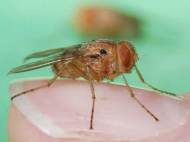Insect hearing biomimicry inspires new approach to small antennas
 Ormia ochracea is a small parasitic fly best known for its strong sense of directional hearing. A female fly tracks a male cricket by its chirps and then deposits her eggs on the unfortunate host. The larvae subsequently eat the cricket. Though it doesn’t work out well for male crickets, such acute hearing in a tiny body has inspired a University of Wisconsin-Madison researcher as he studies new designs for very small, powerful antennas.
Ormia ochracea is a small parasitic fly best known for its strong sense of directional hearing. A female fly tracks a male cricket by its chirps and then deposits her eggs on the unfortunate host. The larvae subsequently eat the cricket. Though it doesn’t work out well for male crickets, such acute hearing in a tiny body has inspired a University of Wisconsin-Madison researcher as he studies new designs for very small, powerful antennas.
For a structure like an antenna to effectively transmit or receive an electromagnetic wave at a given frequency, the size must be comparable to the wavelength at that frequency. Making the structure’s aperture size physically smaller than a wavelength becomes a critical performance issue. These small antennas aren’t as efficient and don’t work well beyond a narrow band of frequencies.
Usually, an insect’s “ears” are not even located on the head, but instead are close together on its thorax or elsewhere, depending on the particular insect. Despite the small time and intensity differences, some insects have directional hearing capabilities surpassing those of humans. The parasitic fly, which appears to be among the smallest with superb directional hearing, can detect the direction of a chirping cricket with an accuracy of one to two degrees.
“These are small antennas that actually work better than large antennas”, said Nader Behdad, an assistant professor of electrical and computer engineering, who took this knowledge and began designing circuits that could mimic an insect’s auditory system. “There hasn’t been any work done to design antennas that mimic the hearing mechanism of different insects. We’ve designed a basic proof-of-concept antenna and have some preliminary results. But at this point, we still need to understand what the physics are.”
Behdad is designing a super resolving type of antenna, which is capable of distinguishing signals coming from different directions. If he can create very small, efficient super-resolving antennas, the technology could result in significantly more wireless bandwidth, better cell phone reception and other applications in the consumer electronics industry, as well as new radar and imaging systems.
He is also interested in eventually using his research to explore small super-directive antennas, a class of antennas that could capture a lot of power coming from one direction. Though this type of antenna is still far from reality, the result could be a tiny antenna with the capabilities of a giant one.









Great application of biomimicry.
Dr.A.Jagadeesh Nellore(AP),India